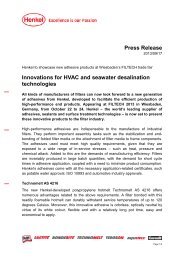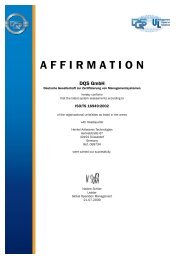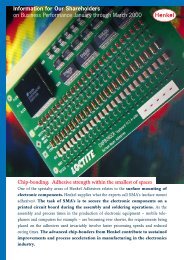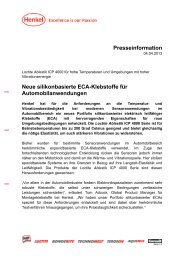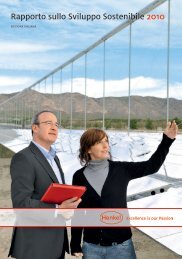Henkel: Alternatives to animal testing
Henkel: Alternatives to animal testing
Henkel: Alternatives to animal testing
Create successful ePaper yourself
Turn your PDF publications into a flip-book with our unique Google optimized e-Paper software.
Research in<strong>to</strong> alternative test methods has so far resulted in the incorporation of a range of new cell and<br />
tissue culture systems in<strong>to</strong> the reper<strong>to</strong>ire of alternative methods. These methods are used <strong>to</strong> investigate the<br />
behavior of a substance in the body or its effect on skin and mucous membranes. A single-layer epidermis<br />
skin model was included in the OECD guidelines several years ago as a method for <strong>testing</strong> skin irritating<br />
properties (see “Alternative test methods” box). Recently, a similar skin model has been approved by the<br />
European Centre for the Validation of Alternative Methods (ECVAM) for <strong>testing</strong> for inflamma<strong>to</strong>ry properties.<br />
<strong>Henkel</strong> and other companies and institutions are working intensively <strong>to</strong> speed up the development of<br />
additional valid alternative methods and intelligent test strategies for reducing and replacing <strong>animal</strong><br />
<strong>testing</strong>.<br />
Alternative test methods<br />
At present there are only seven alternative methods that can replace legally required tests on <strong>animal</strong>s.<br />
The following have been validated and given regula<strong>to</strong>ry approval:<br />
• tests for corrosive properties (OECD 430 and 431),<br />
• tests for acute pho<strong>to</strong><strong>to</strong>xicity or irritation (OECD 432),<br />
• tests for skin absorption (OECD 428), and<br />
• in-vitro methods for determining potentially mutagenic effects (OECD 471, 473, 476).<br />
Further methods are in the validation phase (see http://ecvam.jrc.it).<br />
The Local Lymph Node Assay (LLNA), which has been approved by the OECD as a test for skinsensitizing<br />
properties (OECD 429), makes an important contribution <strong>to</strong> refinement and reduction.<br />
The number of <strong>animal</strong>s needed for certain tests was also reduced by the harmonization of test<br />
requirements and the development of new test methods, such as the Acute Toxic Class Method<br />
(OECD 423) and the Fixed Dose Method (OECD 420) for <strong>testing</strong> for acute oral <strong>to</strong>xicity. The industry<br />
played a decisive role in the development of the test pro<strong>to</strong>cols.<br />
<strong>Alternatives</strong> <strong>to</strong> <strong>animal</strong> <strong>testing</strong><br />
7



